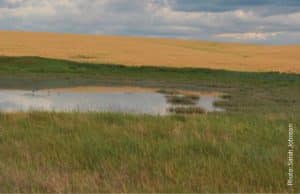Farmers have three good reasons to take chronically unprofitable acres out of annual crop production:
- Stop spending money on acres that don’t provide a return.
- Non-farmed spaces can increase yields for cropped acres.
- Slow the proliferation of weeds and disease.

How do you identify unprofitable acres?
The simple method is to seed field entrances, erodible water runs, saline, wet and weedy areas to perennial forage. You don’t need yield maps to identify these areas. The almost-as-simple step is to overlay a few years of yield maps with input expenses to identify areas that never generate a profit. The advanced step is to bring in professional help. See the original Canola Digest article for more details.
How do you set aside unprofitable acres?
Ideally, growers would have a low maintenance and long-lasting grass to put into those set-aside acres. Calvin Yoder, forage seed specialist Alberta Agriculture and Food, says “one low-maintenance, low-cost species that comes to mind is sheep’s fescue.” As a bunch grass, it won’t creep into the field, plus it’s hardy and “pretty tolerant to a number of herbicides,” he says. See the original Canola Digest article for more details.
New DUC program provides $125 per acre
Ducks Unlimited Canada has a new Marginal Areas Program that provides $125 per acre to seed hard-to-access or poorly-producing areas to perennial forages. DUC lists the benefits of perennial forage: “Forages improve profitability, increase pollinator habitat and biodiversity, reduce herbicide-resistant weeds, act as buffer zones to meet product label guidelines and manage clubroot issues.” The DUC website has more details on the program, the commitment and how to sign up.
